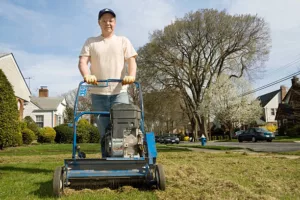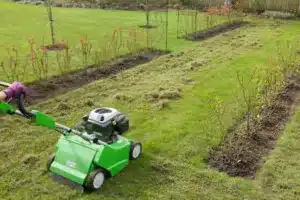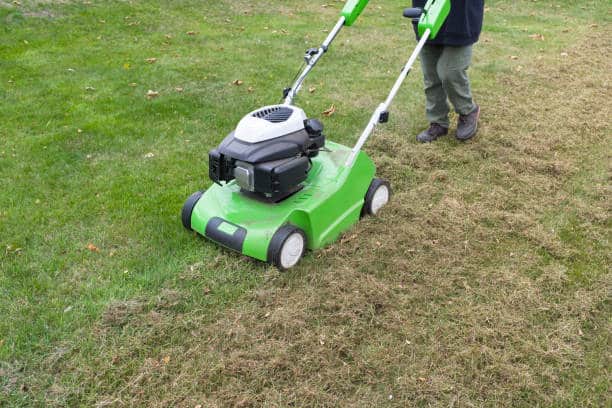Picture this: you step outside on a warm summer day, ready to enjoy your beautiful lawn, only to be greeted by a dry, patchy, and lackluster landscape. If you’ve been struggling with a lawn that just won’t seem to thrive, consider vertimowing.
Vertimowing, also known as vertical mowing or power raking, is a lawn care technique that can help you achieve a lush and healthy green lawn. By removing built-up thatch, improving water and nutrient uptake, and encouraging new grass growth, vertimowing can transform even the most lackluster lawn into a vibrant and resilient landscape.
In this ultimate guide, we’ll explore the benefits of vertimowing, when and how to perform it, and how to care for your lawn afterward. Get ready to transform your lawn with vertimowing and enjoy a lush, healthy, green landscape all season long.
What Is Vertimowing, And How Does It Work?
Vertimowing is a lawn care technique that involves using a special machine to remove built-up thatch and promote healthy grass growth. Thatch is the layer of dead grass, roots, and other debris accumulating between the grass blades and the soil surface over time. While some thatch is necessary for a healthy lawn, the excessive buildup can prevent water and nutrients from reaching the roots and can make your lawn look dull and patchy.

Vertimowing uses a specialized machine with blades or tines that cut through the thatch and into the soil, effectively removing it from your lawn. This process also creates small grooves in the soil, which allows for improved water and nutrient uptake by the grassroots. Additionally, the process of vertimowing stimulates new grass growth by creating space for new shoots to grow.
The best part about vertimowing is that it can be done quickly and easily without causing significant damage to your lawn. While the process may sound intimidating, a professional lawn care provider can help you determine the best technique and timing for your lawn. With proper preparation and aftercare, vertimowing can help you achieve a lush and healthy green lawn that you can enjoy all season long.
Benefits of Vertimowing
Vertimowing is an incredibly effective way to promote a lush and healthy lawn, and it offers a wide range of benefits beyond just improving your lawn’s appearance. Here are some of the top benefits of vertimowing:
- Improved water and nutrient uptake: One of the main benefits of vertimowing is that it creates small grooves in the soil, which helps water and nutrients reach the roots more easily. This means that your grass will be able to grow stronger and healthier, which will make it more resilient to drought and other environmental stressors.
- Reduced thatch buildup: Thatch is a common problem for lawns, and it can prevent water and nutrients from reaching the roots of your grass. Vertimowing is an effective way to remove built-up thatch from your lawn, which will improve its overall health and appearance.
- Encourages new grass growth: When you vertimow your lawn, you create space for new grass shoots to grow. This means that your lawn will become thicker and more lush over time, which will help to prevent weeds from growing and make it more resilient to damage.
- Promotes a thicker, more resilient lawn: Overall, the benefits of vertimowing combine to create a lawn that is thicker, healthier, and more resilient. A thick and healthy lawn not only looks great, but it can also help to prevent soil erosion, reduce the risk of pests and diseases, and provide a safe and comfortable place for your family to enjoy.
In conclusion, vertimowing is an excellent way to promote a healthy and resilient lawn, and it offers a range of benefits that can help to improve the appearance and health of your lawn. By improving water and nutrient uptake, reducing thatch buildup, and encouraging new grass growth, vertimowing can help you achieve the lush and vibrant lawn of your dreams.
When Should You Vertimow?
The best time of year to vertimow your lawn depends on various factors, including your grass type and climate. Generally, the best time to vertimow is during the growing season, when your grass is actively growing and can recover quickly.
For cool-season grasses, such as Kentucky bluegrass and fescue, the best time to vertimow is typically in the spring or fall. Spring is a good time to remove any built-up thatch that has accumulated over the winter, while fall is a good time to prepare your lawn for the winter by removing any dead or diseased grass.

For warm-season grasses, such as Bermuda grass and Zoysia grass, the best time to vertimow is typically in the summer or early fall, when the grass is at its peak growing season. Avoid vertimowing warm-season grasses in the spring, as this can damage the grass and slow down its growth.
It’s also important to consider your climate when deciding when to vertimow your lawn. In areas with mild winters and hot summers, you may need to vertimow more frequently than in areas with more moderate temperatures.
As for how often to vertimow your lawn, this will depend on the amount of thatch buildup and the rate of grass growth. In general, it’s a good idea to vertimow your lawn once or twice a year, but you may need to do it more frequently if your lawn has a lot of thatch buildup. Just be careful not to over-vertimow your lawn, which can damage the grass and create bare patches.
In conclusion, the best time to vertimow your lawn depends on your grass type and climate, and you should aim to vertimow once or twice a year, depending on the amount of thatch buildup and grass growth. By carefully timing and monitoring your vertimowing schedule, you can help to promote a healthy and resilient lawn that will look great all season long.
Mastering the Art of Vertimowing: Techniques for Achieving a Perfectly Lush Lawn
There are two main techniques used in vertimowing: vertical mowing and power raking. Both techniques are effective for removing thatch and promoting healthy grass growth, but they differ in their approach and effectiveness for certain types of lawns.
Vertical Mowing
Vertical mowing, also known as dethatching, involves using a machine with vertical blades that cut through the thatch and create grooves in the soil. This technique effectively removes a significant amount of thatch and promotes deep-root growth. It can also help to aerate the soil, improving the grass roots’ water and nutrient uptake.
Pros:
- Effective for removing a significant amount of thatch
- Promotes deep root growth and improves water and nutrient uptake
- It can help to aerate the soil
Cons:
- It can be invasive and damaging to the grass if not done correctly
- It may require more recovery time for the lawn
Power Raking
Power raking involves using a machine with tines or flail blades that rake through the thatch and remove it from the lawn. This technique effectively removes lighter amounts of thatch and promotes new grass growth. It can also help improve the lawn’s appearance by removing dead grass and debris.
Pros:
- Effective for removing lighter amounts of thatch
- Promotes new grass growth
- Improves the appearance of the lawn
Cons:
- Less effective for deep root growth and improving water and nutrient uptake
- It may not be as effective for removing heavier amounts of thatch
When deciding which technique to use, it’s important to consider the amount of thatch buildup in your lawn and the type of grass you have. For lawns with heavy thatch buildup, vertical mowing may be the better choice. Power raking may be a better option for lawns with lighter thatch buildup or grass that is more sensitive to damage.
In conclusion, both vertical mowing and power raking are effective techniques for vertimowing your lawn, and the choice between the two depends on the amount of thatch buildup and the type of grass you have. By understanding the pros and cons of each technique, you can make an informed decision and achieve the lush, healthy lawn of your dreams.
Preparing Your Lawn for Vertimowing: Essential Steps for Optimal Results
Preparing your lawn for vertimowing is an essential step to achieving optimal results. Here are some tips to help you prepare your lawn for vertimowing:
Mow your grass to the correct height:
- Before you vertimow your lawn, you should first mow your grass to the correct height. The ideal mowing height will depend on your grass type, but in general, you should aim to mow your grass to a height that is between 1/2 and 2/3 of its current height. This will help ensure the vertimower blades can reach and remove the thatch layer effectively.
Remove debris:
- Before vertimowing, removing any debris from your lawn, such as sticks, rocks, and other objects, is important. These items can damage the vertimower blades and create a safety hazard. It is also a good idea to mark out any sprinkler heads in your lawn to avoid damaging them with your vertimower blades.
Adjust the vertimower settings:
- To achieve optimal results, it’s important to adjust the vertimower settings correctly. The depth of the blades should be set based on the amount of thatch buildup in your lawn, with deeper settings used for heavier thatch buildup. It’s also important to adjust the spacing of the blades to ensure that they are evenly spaced and able to remove the thatch effectively.
Water your lawn:
- It’s a good idea to water your lawn thoroughly before vertimowing. This will help to soften the soil and make it easier for the vertimower blades to penetrate the soil and remove the thatch.
By following these steps, you can help ensure that your lawn is ready for vertimowing and that you achieve optimal results. With the right preparation and aftercare, your lawn will be able to thrive and look its best all season long.
Aftercare for Vertimowing: How to Care for Your Lawn to Maintain a Lush and Healthy Appearance
After vertimowing your lawn, it’s important to take proper care of it to maintain a lush and healthy appearance. Here are some tips for aftercare:
Water Your Lawn
- After vertimowing, it’s important to water your lawn deeply and regularly to help it recover from the process. This will help to keep the soil moist and promote new grass growth. Be sure to water your lawn deeply, as shallow watering can cause the roots to grow near the soil surface, making your lawn more susceptible to drought and other environmental stressors.
Fertilize Your Lawn
- Fertilizing your lawn after vertimowing can help to promote healthy grass growth and improve the appearance of your lawn. Look for a fertilizer that is specifically formulated for your grass type and apply it according to the manufacturer’s instructions.
Avoid Mowing Your Lawn For A Few Days
- After vertimowing, it’s best to avoid mowing your lawn for a few days to allow it to recover. This will give the grass time to regrow and fill in any bare spots.
Monitor Your Lawn
- Aftercare also involves monitoring your lawn for any signs of stress or damage. Look for signs of yellowing, thinning, or wilting, which may indicate that your lawn is not getting enough water or nutrients. If you notice any problems, address them promptly to prevent further damage.
Proper aftercare is essential for maintaining a healthy and lush lawn. By watering and fertilizing appropriately and monitoring your lawn for any signs of stress or damage, you can help to ensure that your lawn remains vibrant and resilient. With the right care, your lawn will be able to thrive and look its best all season long.
The Final Cut On Vertimowing
Vertimowing is a highly effective technique for achieving a healthy and lush lawn. By removing thatch buildup, improving water and nutrient uptake, and promoting new grass growth, vertimowing can transform even the most lackluster lawn into a vibrant and resilient landscape.
Additionally, vertimowing can help to prevent soil erosion, reduce the risk of pests and diseases, and provide a safe and comfortable place for your family to enjoy.
If you’re struggling with a lawn that just won’t seem to thrive, consider giving vertimowing a try. With proper preparation and aftercare, vertimowing can help you achieve the lush and healthy lawn of your dreams.
So why not give it a shot and see the benefits firsthand?

Hi there, I’m Mark Apletree, a gardening enthusiast with a passion for gardening, and gardening tools. I’ll be your go-to guide for all things related to gardening. The purpose of this website is to assist you in selecting the most suitable garden gear that meets your specific requirements.
See All Posts

